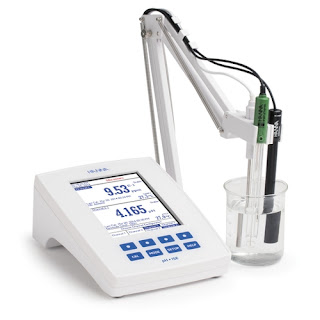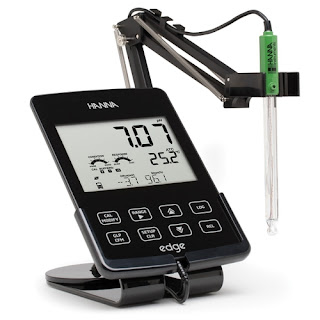PH meter:
It is a scientific tool which is used
to determine alkalinity or acidity of a solution and also recognized as PH. PH
is the entity of measure which defines the degree of alkalinity or acidity. On
a scale of 0 to 14, PH is measured. The PH value represents the level of the
activity of a base or acid with reference to hydrogen-ion activity which is the
quantitative evidence given by the PH value.
Free hydroxyl ions, hydrogen ions are
there in bases and acids respectively. The correlation between hydroxyl and
hydrogen ion in a given solution is persistent for a provided set of terms. By recognizing
the other either one can be determined. A substance of the PH value is purely
related to the proportion of the hydrogen and hydroxyl ion which are H+ and OH-
respectively.
PH and Acidity:
PH is the scale which managed to
determine the total of hydronium ions available in a solution. Acidity is the
total of hydronium ions available in a solution. Thus, PH can measure the
acidity of a system.
Relation:
PH is the logarithmic rate of inverse
of acidity, as acidity is the amount the total of hydronium ions available in a
solution. Lower the acidity of a system, higher the value of PH and vice-versa.
Acidity and PH, both can determine the acidic properties of a solution.
Difference:
Acidity is a qualitative measurement
of a solution which belongs to acidic properties. PH is a quantitative
measurement of basicity or acidity of a solution. Acidity can be quantified in
mol/L units whereas PH value is unitless.
PH and Micro-organisms:
Micro-organism such as bacteria are
vulnerable to the hydrogen ion concentration which they find in their
ecosystem. Huge proteins like enzymes are disturbed by PH. Their structure
changes and the very frequently carries about a variation of the ionic
accusations on the fragment. Acido philes, which are basically microbes that
cultivate optimally at PH less than 5.55. The optimal growth PH is the most
beneficial PH for the expansion of an entity.
How to select a PH meter?
There are four major factors to ensure
when choosing a pH meter that would be properly appropriate for use in
examining production of acidulated foods:
·
Accuracy and resolution of the meter: Few of the less expensive
meters have a precision of minus or plus 0.2 units. In short, if the meter
shows 4.2, then the exact PH of the product may be in between 4.0 to 4.4. This
might appear an issue if the PH of the product considers the permission limit
of 4.5.
Lesser numbers imply improved accuracy and resolution. The lowest cost
meters usually feature a pledge of 0.1 pH units. Centralized organizations
normally need that pH readings be reported to the closest tenth (0.1) unit.
Therefore, technically most units recommend sufficient resolution to fulfil
government standards.
·
Electrode type: Removable probes with meters generally
deliver a select of PH perceiving units which are called electrodes. Maximum
probes feature a glass bulb-based electrode situated at the tip of the probe.
These may be refillable or sealed. Type of refillable may have an extended life
since their design permits them to be reenergized and cleaned when execution
starts to endure. Sealed electrodes need fewer care and also easier to use and
set up.
·
Detachable or all in one probe: Meters possibly available
either with replaceable, detachable probes or may be combined units with an
essential probe. Both kind of probe possibly work similarly well. The combined
units are more suitable and may need fewer maintenance.
·
Auto measurement and temperature compensation: Now Numerous pH meters
available with automatic calibration buffer sensing or automatic sample
temperature compensation. These are accessibilities that make it simpler to regulate
the meter and to assess the pH of samples.
PH meter Calibration:
Calibration of a pHmeter is achieved by utilizing measuring elements with
known pH levels which are called buffers and adjusting
the pH measurements to those levels on the pH meter. The pH
meter utilizes the calibration measurements as a reference in
the measuring of other elements.
Why are PH values Measured?
PH is a rate of how basic or acidic
water is. The range varies from 0 to 14. Being neutral when the PH range is at
7, acidity indicate when the PH value is less than 7 whereas basic indicate
when the PH value is greater than 7. PH is especially a measurement of the comparative
amount of free hydroxyl and hydrogen ions present in water.
How are PH values measured?
The value of PH can be quantified by
using Litmus paper or indicators, colorimeter, and electrochemical gauging
systems. The simplest way to keep a PH measurement is to utilize a colorimeter
or a Litmus paper. The benefit of this kind of Ph measurement is that the PH
range is well recognised, and they are simple to apply.
The extremely trendy method is to utilize
an electrode designed to permit hydrogen ions in a solution to go through a specific
barrier which generates a quantifiable capacity difference proportionate to the
solutions of PH.
Applications of PH measurement:
PH meters are used for water quality
measurement at swimming pools, municipal water supplies, distilling of beer or
wine production, environmental remediation, clinical and healthcare
applications like blood chemistry and various other applications.
Improvements in the equipment and in
detection have prolonged the number of applications in which the measurements
of PH can be performed. The tools have been reduced which allowing direct
measurement of PH innermost of living cells.
PH best practices:
1. Maintain the electrode
hydrated:
Because exposure to air the electrode directs to gliding pH values, inaccurate
measurements, and slow response times.
2. Wash do not wipe your
electrode:
Because distributing the pH glass can generate a stagnant charge which affects
with the pH reading of the electrode.
3. Keep your electrode in
stowage solution: Because keeping in DI (deionized water) origins ions to percolate from
the glass membrane and allusion electrolyte causing in a sluggish and
deliberate response.
4. Clean your electrode on a
regular basis: Because deposits can develop on the electrode during use, coating the
detecting glass. This can run to inaccurate readings and calibrations.
5. Calibrate regularly: Because all PH probes
require to be calibrated every so often for greatest precision.
6. Choose the right electrode
for your experiment: Because Common objective electrodes are efficient for a broad range of
applications but not perfect for all experiments.
7. Slacken or open the fill
hole cap:
Because a locked electrode fill hole may possibly start to slower equilibrium
times.
8. Retain electrolyte level
full:
Because Electrolyte streams out from the allusion junction over time. Minimal
electrolyte levels may possibly affect unreliable readings.
9. Correctly immerse your
electrode:
Because Both the reference junction and pH sensing glass require to be entirely submerged
in order to operate accurately.
10. Examine your electrode: Over a period of time, the
detecting portion of the glass turn into less reactive and will ultimately
fail. Destruction from usage is also feasible. This will produce incorrect
readings.



No comments:
Post a Comment